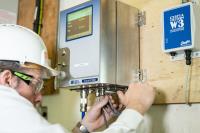 Add My Company
Add My Company
Sign In
A whole-site approach to radiation alarms
08-12-2020

The role of safety critical alarm annunciators in radiological applications
When handling radioactive materials, it’s worth paying attention to the details. Personal dose meters, protective equipment and gloveboxes are extensively used, but what if measures fail, and containment is lost? Here, Gary Bradshaw, director at alarm annunciation specialist Omniflex, discusses the problems associated with existing radiological monitoring systems and how to overcome them.
As substances go, there are few that require more care and attention than radioactive materials. Regulations set by the Health and Safety Executive (HSE) and Office of Nuclear Regulators (ONR) outline the need to tightly monitor radiation levels, so workers are not unknowingly exposed to harmful doses. If radiation doses in the environment reach harmful levels, it leads to significant consequences both in terms of financial impact and health issues for workers.
Radioactive materials are widely used across several key industrial sectors including using radioactive carbon isotopes for carbon dating applications or using radioactive oxygen isotopes in positron emission tomography (PET) scanners in hospitals worldwide.
The positron conundrum
Because of the short half-lives associated with most positron-emitting radioisotopes, the radiotracing material must be produced using a cyclotron near the PET imaging facility. Therefore, it is a common occurrence for radioactive materials to be produced near to large population centres to service the demands of local hospitals.
To comply with regulatory standards regarding environmental emissions and workplace safety, all PET centers are legally required to monitor on-site radiation levels. This is necessary for both the isotope production and patient care areas of the facility. However, despite the volume of regulations concerning handling radioactive materials, there is little authoritative guidance on finer points like the integration of alarm systems into a site’s supervisory control and data acquisition (SCADA) systems.
Relying on control systems full of complex visualisations in the event of imminent danger is a risky move. These systems often contain a mixture of critical and non-critical alarms, with no clear distinction between the two or an established order of priorities.
Addressing this is a top priority for diligent radiological site managers. Currently, some rely on physical equipment checks recorded into basic spreadsheet databases, which is inefficient and leaves room for human error. Alternatively, some integrate the alarms into the site’s building management system, despite it not being designed to process alarm data, meaning key information can be missed.
A better way
To overcome the limitations of the methods currently in use, Omniflex applies its expertise as an alarm annunciation specialist to develop a flexible, easy-to-integrate radiological monitoring system.
Instead of inefficient physical inspections, all alarm annunciation data is uploaded to the site’s SCADA system. And, for safety-critical alarms, physical alarm annunciators are installed and directly hardwired into the relevant processes. In the event of a system failure or containment breach, the relevant window lights up and the alarm emits the sound, giving operators the necessary information to act immediately.
Each window on the annunciator panel is permanently dedicated to a specific process, improving operator awareness so that any alarm states can be recognised and acted on immediately without the potential for confusion. Furthermore, windows are colour coded to indicate the severity of the alarm so that, if multiple alarms sound, there is an order of priorities already in place.
Thanks to the modularity of Omniflex’s systems, adding in cloud or mobile connectivity is easy. This means that, in the event of an alarm, SMS or email alerts can be sent immediately to relevant personnel.
Confusion is the last needed in the event of a radiological containment breach, so keeping alarm systems lean and efficient is crucial. Otherwise, the little errors that make the difference between a minor and major radiological incident can creep in.
To find out more about how to implement safety-critical alarm annunciators in your facility, get in touch with Omniflex on +44 (0) 161 491 4144 or visit the website.
For more information on A whole-site approach to radiation alarms talk to Omniflex UK Limited
Enquire Now
List your company on FindTheNeedle.

